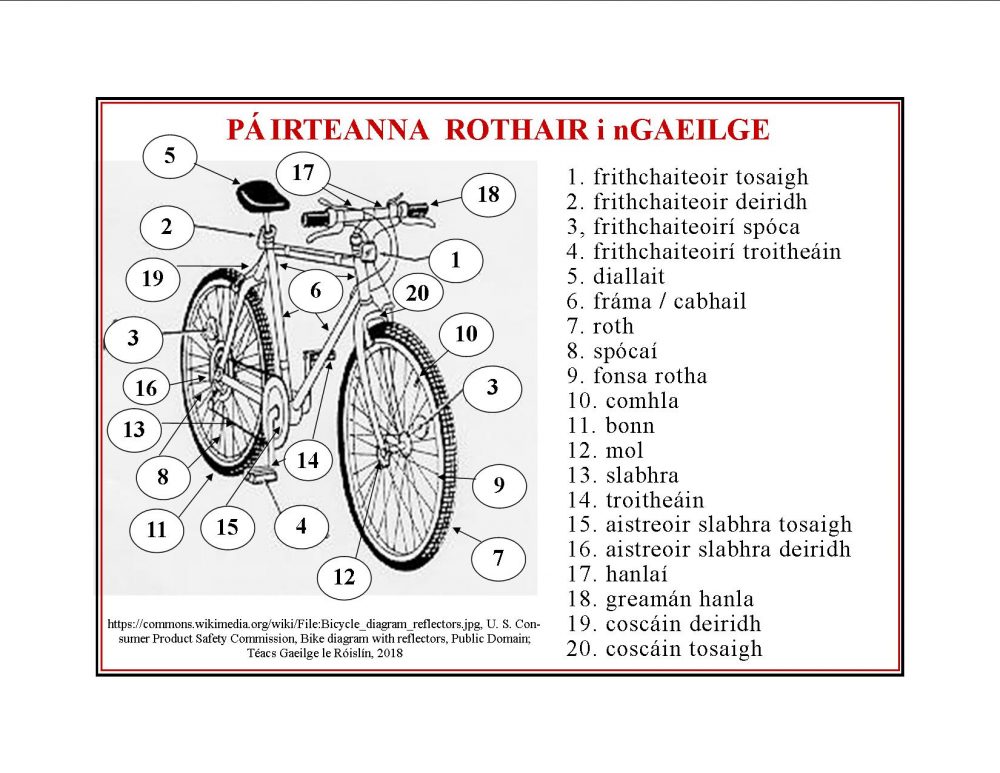PÁIRTEANNA ROTHAIR i nGAEILGE (Parts of a Bicycle, in Irish) Posted by róislín on May 20, 2018 in Irish Language
(le Róislín)
Inspired by doing the blogpost on cyclist extraordinaire and octogenarian Dervla Murphy (nasc thíos), I decided to do a little more on bicycles before moving on to some other topics. So let’s go through a list of some of the parts of a typical bicycle. I’m sure that for a meicneoir rothar proifisiúnta, there would be even more parts, but fiche téarma seemed like a good place to start. So here they are in numerical order, matched to the graphic above, with a few background and pronunciation notes.
- frithchaiteoir tosaigh, front reflector, very lit. something like “anti-thrower” if we could ever fathom such a compound word. “Frith-” also shows up in words like frithbheathach (antibiotic) and frithghníomh (counteraction, reaction). “Caiteoir” is based on the multi-purpose verb “caith,” and can mean the following: consumer, wearer, spender, pitcher, shooter, smoker, user, feeder, and thrower.
- frithchaiteoir deiridh, rear deflector
- frithchaiteoirí spóca, spoke reflectors
- frithchaiteoirí troitheáin, pedal reflectors
- diallait, saddle
- fráma / cabhail, frame (both words mean “frame”)
- roth, wheel (remember: the “th” is silent or a slight breathy sound, but not actual “t” or “h”)
- spócaí, spokes
- fonsa rotha, wheel rim
- comhla, valve (remember: the “mh” is silent, but makes the “o” long)
- bonn, tire. This word also means foundation, basic, track, foothold, and sole (of the foot). But it is a completely different word from the lookalike “bonn” meaning “coin” or “medal.”
- mol, hub. Also used for “pole,” as in “An Mol Thuaidh” and “An Mol Theas,” which are also known as “An Pol Thuaidh” and “An Pol Theas,” respectively. My favorite Irish language theory — why have just one word for something, when you could have two, or more? Of course, English sometimes does this, too, said the the “tiny wee man” or should that be the “teeny-tiny man.” It’s just that there doesn’t really seem to be an iota of innuendo difference between Pol Thuaidh and Mol Thuaidh. Hmmm…
- slabhra, chain [the “abh” is typically pronounced “ow” as in “cow,” or as in when you hit your thumb with a hammer]
- troitheáin, pedals.The singular (for one pedal or a pedal) would be “troitheán.” This is based on the word “troigh” (foot), used for a “foot” in measurement (twelve inches), and formerly used for the foot on the body. Nowadays, “cos” is mostly used for “foot,” although, confusingly, it can also mean “leg.” Related words based on “troigh” include “troitheach” (foot-soldier) and “troithín” (the tread of a spade). Why the change from final “-gh” to final “-th”? Hard to say exactly, but I can note that the plural of
“troigh” is “troithe,” and it used to be spelled “troighthe,” much like plural of “teach” (house) currently spelled “tithe” (houses) used to be spelled “tighthe,” which was much more logical, at least in my opinion. . - aistreoir slabhra tosaigh, front derailleur, lit. front chain changer
- aistreoir slabhra deiridh, rear derailleur, lit. rear chain changer
- hanlaí, handlebars
- greamán hanla, handlebar grip
- coscáin tosaigh, front brakes
- coscáin deiridh, rear brakes.
Bhuel, tá súil agam go raibh sé seo suimiúil. SGF — Róislín
Nasc don iarbhlagmhír faoi Dervla Murphy:
Cé a chuaigh ó Éirinn go dtí an India ar rothar (Which Irish cyclist went from Ireland to India by bike) agus ar an ábhar sin, cén Ghaeilge atá ar ‘full tilt’?Posted by róislín on May 15, 2018 in Irish Language
Agus maidir leis an rothar a bhí ag Dervla Murphy (‘Roz’ aka Rozinante): https://groups.google.com/forum/#!topic/rec.bicycles.tech/QnY09W3lyok

Build vocabulary, practice pronunciation, and more with Transparent Language Online. Available anytime, anywhere, on any device.





Leave a comment: